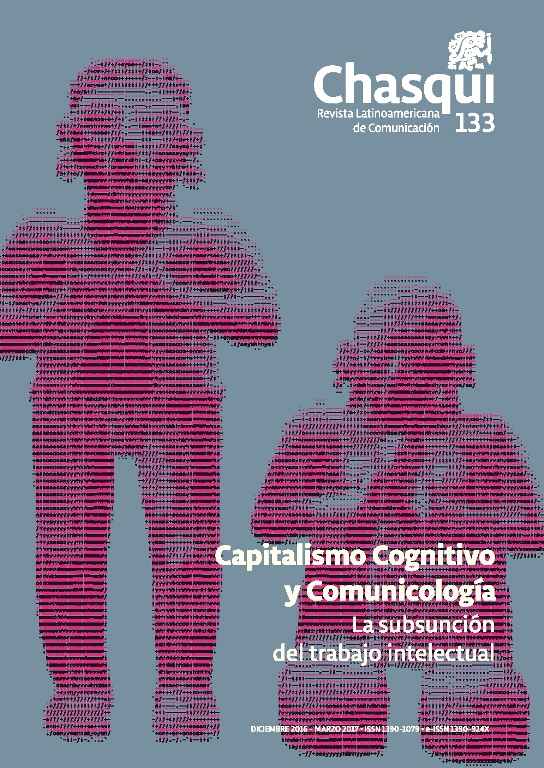Cultural diversity in communication policies: a comparative analysis of Spain and Argentina
DOI:
https://doi.org/10.16921/chasqui.v0i133.2770Keywords:
audiovisual, UNESCO, cultural diversity, public policies, quotasAbstract
Cultural diversity has returned to the communication and cultural policies agenda since the adoption of the UNESCO Convention on the protection and promotion of the diversity of cultural expressions in 2005. Nevertheless, research about its implementation reveals that the treaty has been interpreted in very different ways. This article analyses the way in which the concept of cultural diversity was applied to audiovisual policies in Spain and Argentina. The main idea to prove is that the vagueness of the Convention has allowed governments with different political orientations to support policies that promote cultural diversity from a rhetoric point of view but that do not, for instance, question their existing positioning.References
Albornoz, L. A. & García Leiva, M. T. (Eds.) (2017a). Diversidad e industria audiovisual: el desafío cultural del siglo XXI. México D. F.: Fondo de Cultura Económica (en prensa).
Albornoz, L. A. & García Leiva, M. T. (Eds.) (2017b). El audiovisual en la era digital. Políticas y estrategias para la diversidad. Madrid: Cátedra (en prensa).
Baltà, J. (2014). Evaluation of UNESCO’s Standard-setting Work of the Culture Sector. Part IV–2005 Convention on the Protection and Promotion of the Diversity of Cultural Expressions. Paris: UNESCO.
Becerra, M. & Mastrini, G. (2009). Los dueños de la palabra. Acceso, estructura y concentración de los medios en la América Latina del siglo XXI. Buenos Aires: Prometeo.
Bernier, I. (2008). La Convención sobre la diversidad de las expresiones culturales de la UNESCO: un instrumento cultural en la confluencia del derecho y de la política. Bulletin de nouvelles sur la diversité des expressions culturelles, 8(19), pp. 1-27.
Bernier, I. & Ruiz Fabri, H. (2006). Implementing the UNESCO Convention on the Protection and Promotion of the Diversity of Cultural Expressions – future actions. Québec: Direction générale du secrétariat et des communications, Ministère de la Culture et des Communications.
Bustamante, E. (2013). España: La cultura en tiempos de crisis. Fuentes financieras y políticas públicas. Documento de trabajo 12/2013 para el Observatorio de Comunicación y Cultura de la Fundación Alternativas. Recuperado de http://bit.ly/2hcFEAJ.
Bustamante, E. (Coord.). (2016). El estado de la cultura en España 2016. La cultura como motor de cambio. Madrid: Fundación Alternativas & Catarata.
CE (2012). Commission Staff Working Document Quadrennial Periodic Report on behalf of the European Union on measures to protect and promote the diversity of cultural expressions in the framework of the 2005 UNESCO Convention. SWD(2012)129 final, 23/5/2012. Bruselas: Comisión Europea (CE).
De Beukelaer, C.; Pyykkonen, M. & Singh, P.J. (Eds.) (2015). Globalization, Culture and Development: The UNESCO Convention on Cultural Diversity. Basingstoke: Palgrave Macmillan.
García Leiva, M. T. (2015a). España y la Convención sobre Diversidad Cultural: consecuencias de su ratificación para las políticas de comunicación y cultura. Trípodos, 36, pp. 59-75.
García Leiva, M. T. (2015b). La Convención sobre diversidad cultural y la cooperación española en materia de cultura. Revista Investigación & Desarrollo, 23(2), pp. 439-463.
García Leiva, M. T. (2016). Política audiovisual europea y diversidad cultural en la era digital. Comunicación y Sociedad, 27, pp. 221-241.
Germann Avocats (2010). Aplicación en la Unión Europea de la Convención de la UNESCO de 2005 sobre la Protección y Promoción de la Diversidad de las Expresiones Culturales. Estudio solicitado por la Comisión de Cultura y Educación del Parlamento Europeo. Ginebra: Departamento Temático B: Políticas estructurales y de cohesión, Parlamento Europeo.
Kulesz, O. (2014). UNESCO Convention on the Protection and Promotion of the Diversity of Cultural Expressions: Analysis of Parties’ periodic reports and contemporary digital trends. Information Document prepared for the 8th ordinary session of the Intergovernmental Committee for Protection and Promotion of the Diversity of Cultural Expressions París: UNESCO.
Loisen, J. (2015). The implementation of the UNESCO Convention on the Protection and Promotion of the Diversity of Cultural Expressions in EU external relations. En E. Psychogiopoulou (Ed.), Cultural Governance and the European Union Protecting and Promoting Cultural Diversity in Europe (pp. 210–224). Basingstoke: Palgrave Macmillan.
Loreti, D. (2012). La libertad de expresión, los principios de desconcentración en el derecho internacional de los derechos humanos y la consistencia de la ley de servicios de comunicación audiovisual. Cuadernos del INADI, 7, julio, 2-8.
MCU (2011). Plan de fomento de las industrias culturales y creativas 2011. Madrid: Ministerio de Cultura (MCU).
Obuljen, N. & Smiers, J. (2006). UNESCO’s Convention on the Protection and Promotion of the Diversity of Cultural Expressions. Making it work. Zagreb: Institute for International Relations.
Przeworski, A. y Henry, T. (1970). The Logic of Comparative Social Inquiry. John Nueva Jersey: Wiley.
Psychogiopoulou, E. (Ed.). (2015). Cultural Governance and the European Union Protecting and Promoting Cultural Diversity in Europe. Basingstoke: Palgrave Macmillan.
Richieri Hanania, L. (Ed.). (2014). Cultural Diversity in International Law. The effectiveness of the UNESCO Convention on the Protection and Promotion of the Diversity of Cultural Expressions. Abingdon: Routledge.
Secretaría de Estado de Cultura (2012). Plan estratégico general 2012-15. Madrid: Ministerio de Educación, Cultura y Deporte (MECD).
UNESCO (2005). Convención sobre la promoción y protección de la diversidad de las expresiones culturales. París: UNESCO
Zallo, R. (2010). La política de comunicación audiovisual del gobierno socialista (2004-2009): un giro neoliberal. RLCS, 65, pp. 14-29.
Downloads
Published
Issue
Section
License
- Authors retain copyright and grant the journal right of first publication with the work simultaneously licensed under a Creative Commons Attribution-NoDerivs License (CC BY-ND) that allows others to share the work with an acknowledgement of the work's authorship and initial publication in this journal.
- Authors are able to enter into separate, additional contractual arrangements for the non-exclusive distribution of the journal's published version of the work (e.g., post it to an institutional repository or publish it in a book), with an acknowledgement of its initial publication in this journal.
- Authors are permitted and encouraged to post their work online.

